Infrastructure in
America
Privatizing Public Health
In the spring of 2019, a team of students at the Buell Center working on the "Architecture and Engineering Services" initiative sought to better understand the major players, financing, and timelines of specific architectural projects that were significantly affected by Hurricane Katrina. And for each of them, while many questions were answered, many more emerged—illustrating both the potentials and difficulties of tracing the financial, technical, and political paths of power through the built environment. The below research, by Alicia French (GSAPP MArch '19), takes a close look at the transformation of the city's hospital system through the lens of University Medical Center New Orleans, connecting forced displacement and public investment under the ever-privatizing aegis of 'public' health.
CONTEXT
On August 29, 2005, Hurricane Katrina struck New Orleans and its environs, precipitating a flooding catastrophe that devastated the region. During the event, most of the city's hospitals were evacuated and were either permanently closed or acquired by larger private corporate entities (such as Ochsner Health Services, which operates multiple hospitals and clinics in the New Orleans area). Before Katrina, in addition to the VA, New Orleans housed two public hospitals with storied histories: University Hospital and Charity Hospital. After Katrina, both hospitals’ operations would be subsumed into the LSU Interim hospital; in 2013 this hospital was leased by LCMC Health, a medical nonprofit fashioned from the leadership of two other New-Orleans based hospitals, a move which left the New Orleans region with zero remaining public hospitals. LCMC Health eventually opened University Medical Center New Orleans (UMCNO), a private non-profit hospital, largely with state and FEMA money.
KEY PLAYERS
LCMC Health - Louisiana Children’s Medical Center Health, a private nonprofit group formed from the leadership of multiple NO area hospitals
Former Governor Bobby Jindal - Major political supporter of UMCNO, the decision to massively privatize health care across the state largely attributed to his politics
LSU Hospitals - Louisiana State University has operated a number of medical facilities since the mid-1990s, most used as teaching hospitals, throughout the state. They ran Charity and University Hospitals and currently run the state-of-the-art University Medical Center New Orleans.
LSU Real Estate & Facilities Foundation - Body of LSU responsible for developing and maintaining facilities as well as planning new ones: they were involved in both the planning of UMCNO and the current redevelopment of Charity Hospital.
Foundation for Historical Louisiana - major critic of UMCNO, led an attempt to save historic structures in the neighborhood. Raised $600k for architecture firm RMJM Hillier to conduct an independent study of the damage to Charity Hospital (they ultimately found it suitable for renovation).1
Beverly Construction- Louisiana-based company, contractor for earthwork and utilities (paid $25 million)
Skanska/MAPP - General Contractors for UMCNO
NBBJ / Blitch Knevel Architects - Architects
AECOM - (formerly URS, Structural, MEP, and Civil) consultants, engineering
FUNDING
$300 million - State of Louisiana, general funds given to the project
$474.7 million (construction costs) + $50 million (equipment) - FEMA
$375.3 million (projected, facility) + $150 million (initial working costs) - Loans2
“A&E SERVICES”
There is an often significant discrepancy between what government contracting officials label as "A&E" (Architecture & Engineering) and what students and professionals from the field would include in that category. The timeline below seeks to highlight both perspectives.
North American Industry Classification System (NAICS) codes appear as long as Federal Agencies are involved:
- 233320: Building, Developing, and General Contracting
- 236210, 236220: Industrial Building Construction
- 238110–238990: Specialty Trade Contractors
- 541310: Architecture Services
- 541320: Landscape Architectural Services
- 541330: Engineering Services
- 541350: Building Inspections
- 541360: Geophysical Surveying and Mapping Services
Other, speculatively identified, non-coded “A&E Services” are shown in italics.
TIMELINE
Pre-Katrina
LSU receives significant state funding in order to finance and operate ten inpatient hospitals and a network of more than 350 clinics that primarily serve uninsured people.3
August 29, 2005
Katrina strikes, and University and Charity hospitals, both public, are damaged in the storm (but not irreparably).
2006
238110–238990: Specialty Trade Contractors
Competing claims to the level of wind and flooding damage at Charity Hospital are made, with each party hiring its own team to conduct a facilities assessment of the site and develop an estimate of repair costs. The LSU estimate triggers the 50 percent threshold for repair versus replacement: if a repair costs more than 50 percent of the replacement value of the facility, a replacement is favored by FEMA. Meanwhile, estimates from both FEMA and the Foundation for Historical Louisiana (and the firm they hire, RMJM Hillier) indicate that a repair or even a complete retrofit would be the more cost-effective choice.4
In the end, however, the new facility did not cost the estimated $395 million, but rather $1.2 billion for the massive, state-of-the-art University Medical Center New Orleans.5
2009
233320: Building, Developing, and General Contracting
State announces its intent to demolish this particular section of Mid-City. A freeze on new permits is now in place.6
January 22, 2009
At the same time that LSU is testifying before the legislature in Baton Rouge and listing the project’s shared services, a Section 106 public meeting is being held in New Orleans, where the designs show no shared services.7
November 2009
The City agrees to acquire thirty-four acres between Galvez and Rocheblave for the VA hospital and University Medical Center New Orleans. Use of eminent domain is planned.8
2010
541320: Landscape Architectural Services
Some design modifications—like more green space in the medical campus—is agreed to after the public is critical of the development.9
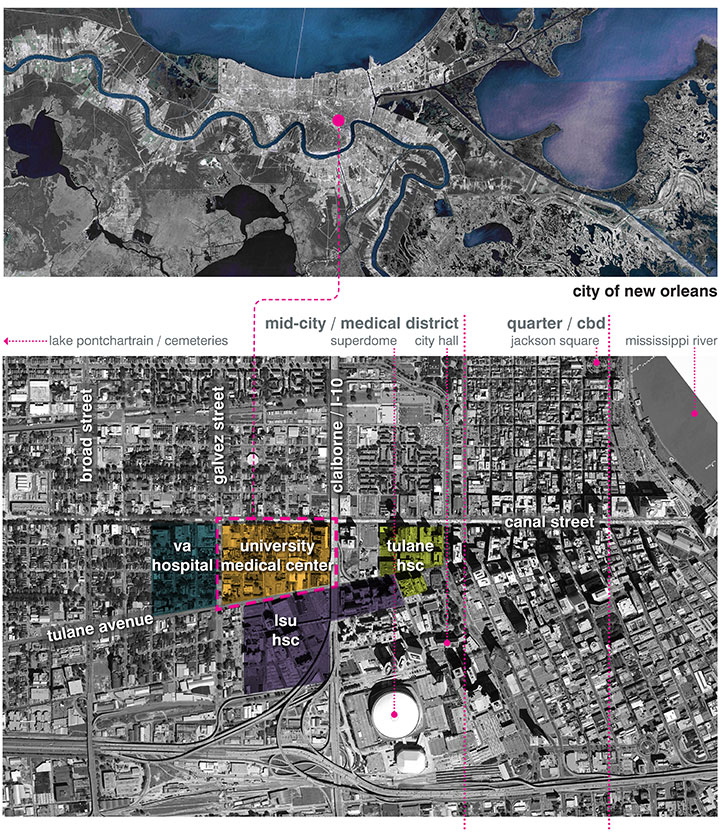
Proposed master plan for a New Orleans "Health Care District" (NBBJ)
Summer 2010
A $3.2 million program to move as many as 100 homes from the planned VA hospital footprint, adjacent to the UMC site, is initiated.10
2011
541310: Architectural Services
A five-year, $0 to $240 million, open-ended contract with NBBJ is signed.11
May 22, 2011
There is still no agreed-upon business plan for UMCNO. The state expects to spend $100 million annually to support the facility, up from the initial projection, which was around $70 million.12
2012
Multiple entities file suit against the state for undervaluing their property when using eminent domain.13
2013
238110–238990: Specialty Trade Contractors
The State of Louisiana and LCMC Health enter into an official, no-bid contract to provide a "charity hospital" for the state.14
2014
A federal investigation of the UMCNO rental fee begins after the Centers for Medicare and Medicaid Services allege that the LCMC paid the state an inflated amount for the lease of the original LSU hospital while counting on more Medicaid payments once the hospital opened.15
June 11, 2015
LCMC Health earns about $25 million more than originally requested from the Louisiana state government.16
August 1, 2015
UMCNO opens to first patients. 17
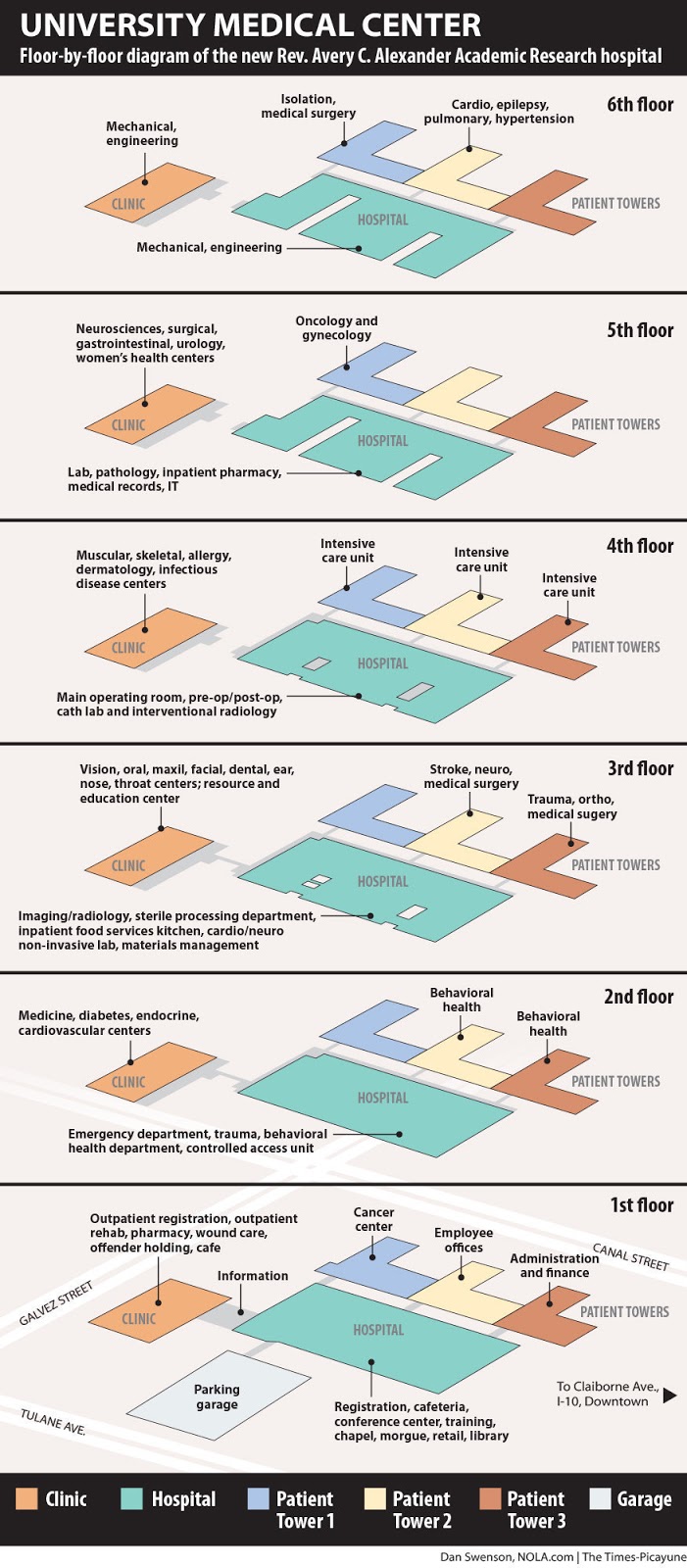
Floor-by-floor diagram of UMCNO (nola.com)
September 1, 2015
236210, 236220: Industrial Building Construction
The New Orleans area lost more jobs than any other urban area in the country from July 2014 to July 2015. With the end of construction on UMCNO, the last of the large post-Katrina construction jobs comes to a close.18
November 29, 2016
LCMC Health begins an 18-month plan to develop seven urgent care centers in the New Orleans area.19
February 2016
UMCNO faces a $44 million budget cut and bands together with other hospitals to consider walking away from their agreement with the state.20
July 6, 2017
Louisiana is ordered to pay $5.4 million to the federal government to settle a debt tied to former Gov. Bobby Jindal's privatization of the Charity Hospital system: representatives of the federal government originally sought $190 million.21
2018
541360: Geophysical Surveying and Mapping Services
541310: Architectural Services
LSU currently managing a “comprehensive land use study” on Charity Hospital. Studio O of San Francisco was hired for the project's design + consulting. The redevelopment is expected to cost between $260 and $285 million dollars. 22
April 16, 2018
Charity Hospital is back out for bids, with an RFP being circulated.23
NOTES
- 1Roberta Brandes Gratz, "Why Was New Orleans's Charity Hospital Allowed to Die?" The Nation, April 27, 2011, https://www.thenation.com/article/why-was-new-orleanss-charity-hospital-allowed-die/.
- 2Verité Healthcare Consulting, LLC, "Business Plan Analysis University Medical Center, New Orleans," April 2010. https://thelensnola.org/wp-content/uploads/2011/09/Business-Plan-Analysis-05-11-2010-Verite-Levine.pdf.
- 3Robin Rudowitz, Diane Rowland, and Adele Shartzer, "Health Care In New Orleans Before And After Hurricane Katrina," Healthaffairs.org, September/October 2006, https://www.healthaffairs.org/doi/full/10.1377/hlthaff.25.w393.
- 4Roberta Brandes Gratz, "Why Was New Orleans's Charity Hospital Allowed to Die?" The Nation, April 27, 2011, https://www.thenation.com/article/why-was-new-orleanss-charity-hospital-allowed-die/. Government Accountability Office, "Hurricane Katrina: Status of Hospital Inpatient and Emergency Departments in the Greater New Orleans Area," govinfo.gov, September 29, 2006, https://www.govinfo.gov/content/pkg/GAOREPORTS-GAO-06-1003/html/GAOREPORTS-GAO-06-1003.htm.
- 5"Review The Plans," Save Charity Hospital, http://savecharityhospital.com/content/review-plans.
- 6Bill Barrow, "State expropriation for new hospital includes those who rebuilt after Katrina," nola.com, November 29, 2009, https://www.nola.com/politics/2009/11/post_175.html.
- 7Susan Buchanan, "Downtown Property Owners Sue as Hospitals are Built," Louisiana Weekly, August 13, 2012, http://www.louisianaweekly.com/downtown-property-owners-sue-as-hospitals-are-built/.
- 8"Site Clearing in Mid-City Begins for New Hospital Sites—NOLA Preservation Timeline Entry," Tulane School of Architecture, http://architecture.tulane.edu/preservation-project/timeline-entry/1419. Jared Munster, "They Took My Bedroom: A Case Study of Eminent Domain in New Orleans," Dissertation, University of New Orleans, 2012.
- 9Kate Moran, "Plans for LSU-VA hospital complex stir resentment," nola.com, February 24, 2008, https://www.nola.com/news/2008/02/plans_for_lsuva_hospital_compl.html. Adam Nossiter, "Plan for New Orleans Hospitals Draws Outcry," New York Times, November 25, 2008, https://www.nytimes.com/2008/11/26/us/26hospital.html.
- 10Bill Barrow, "4 Mid-City structures will be first to fall for new VA hospital," nola.com, April 29, 2010, https://www.nola.com/politics/2010/04/4_mid-city_structures_will_be.html. Bill Barrow, "Relocation of historic homes from Veterans Affairs hospital footprint nearly complete, nola.com, January 28, 2011, https://www.nola.com/health/2011/01/relocation_of_historic_homes_f.html.
- 11USAspending.gov, Award ID 0001, Parent Award ID W912DY13D0122.
- 12Bill Barrow, "University Medical Center would need $100 million state subsidy annually, consultants say," nola.com, June 3, 2011, https://www.nola.com/politics/2011/06/consultants_peg_yearly_state_s.html.
- 13Buchanan, "Downtown property owners sue as hospitals are built."
- 14According to the New York Times, “Under its contract with the state, LCMC Health, the private nonprofit operator of University Medical Center, is obligated to provide free or reduced-cost care to all indigent and uninsured patients, ‘subject to the receipt of the required funding.’” The term “charity hospital” was used to refer to public hospitals in the state, and it is arguable whether or not this facility is readily available to the same patients that once used the public hospitals (Charity and University Hospitals) for their medical needs. Abby Goodnough, "New Orleans Hospital Is Replaced, With Hope of Preserving Its Mission," New York Times, December 21, 2017, August 1, 2015, https://www.nytimes.com/2015/08/02/us/new-orleans-hospital-is-replaced-with-hope-of-preserving-its-mission.html. Associated Press, "Privatization of LSU Hospitals Leaves Medical School with 'legacy Costs.'" nola.com. April 17, 2015, https://www.nola.com/health/2015/04/post_46.html.
- 15Office of the Governor, "State Settles Private Hospital Financing Dispute with CMS," Office of the Governor, July 6, 2017, http://gov.louisiana.gov/index.cfm/newsroom/detail/925. Ben Myers, "Feds Pose New Questions about University Medical Center Deal, Rent Breaks for Operator," nola.com, August 21, 2014, Accessed April 16, 2019. https://www.nola.com/politics/2014/08/feds_pose_new_questions_about.html.
- 16Rebecca Catalanello, "University Medical Center a winner in final budget," nola.com, June 12, 2015, https://www.nola.com/health/2015/06/university_medical_center_a_wi.html.
- 17Jacobs, "New Facilities for the University Medical Center," Louisiana Division of Administration, https://www.doa.la.gov/ofpc/Main%20Page%20FPC/9-19-610-06B-04,%20Part%2012,%20MoRpt%20March%202015-Final.pdf. Abby Goodnough, "New Orleans Hospital Is Replaced, With Hope of Preserving Its Mission," New York Times, August 1, 2015, https://www.nytimes.com/2015/08/02/us/new-orleans-hospital-is-replaced-with-hope-of-preserving-its-mission.html.
- 18Jennifer Larino, "Why is New Orleans losing so many construction jobs?" nola.com, July 29, 2015, https://www.nola.com/politics/2015/07/new_orleans_construction_jobs.html.
- 19Jed Lipinski, "Hospital network to create 7 urgent care clinics in New Orleans," nola.com, September 27, 2016, https://www.nola.com/health/2016/09/lcmc_health_new_orleans.html.
- 20Kevin Litten, "University Medical Center and other hospitals for the poor are considering walking away from their state contracts," nola.com, February 18, 2016, https://www.nola.com/politics/2016/02/hospital_closure_budget_cuts.html.
- 21Office of the Governor, "State settles private hospital financing dispute with CMS," Office of the Governor, July 6, 2017, http://gov.louisiana.gov/index.cfm/newsroom/detail/925.
- 22"Nationally Recognized Architectural Firm Says Charity Hospital 'Structurally Sound' and Ready for Transformation to State-of-the-Art Medical Facility," Foundation for Historical Louisiana, pp.1-49, 2008. Jeremy Harper, "Rebuilding Charity: Officials Hope ULI Study Jump-Starts Redevelopment of Shuttered New Orleans Hospital," Urban Land Institute, February 14, 2018, https://urbanland.uli.org/planning-design/rebuilding-charity-officials-hope-uli-study-jump-starts-redevelopment-shuttered-new-orleans-hospital.
- 23Kevin Litten, "Possible layouts emerge for Charity Hospital redevelopment," nola.com, February 20, 2019, https://expo.nola.com/news/g66l-2019/02/805bb47b779026/possible-layouts-emerge-for-charity-hospital-redevelopment-.html.
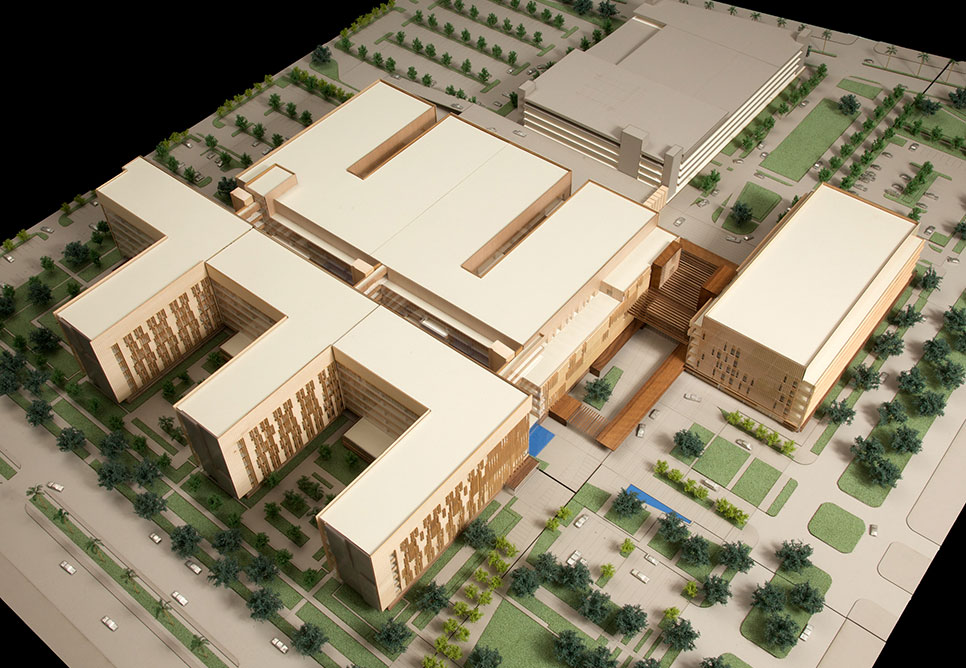
Model of the UMCNO Center (NBBJ)
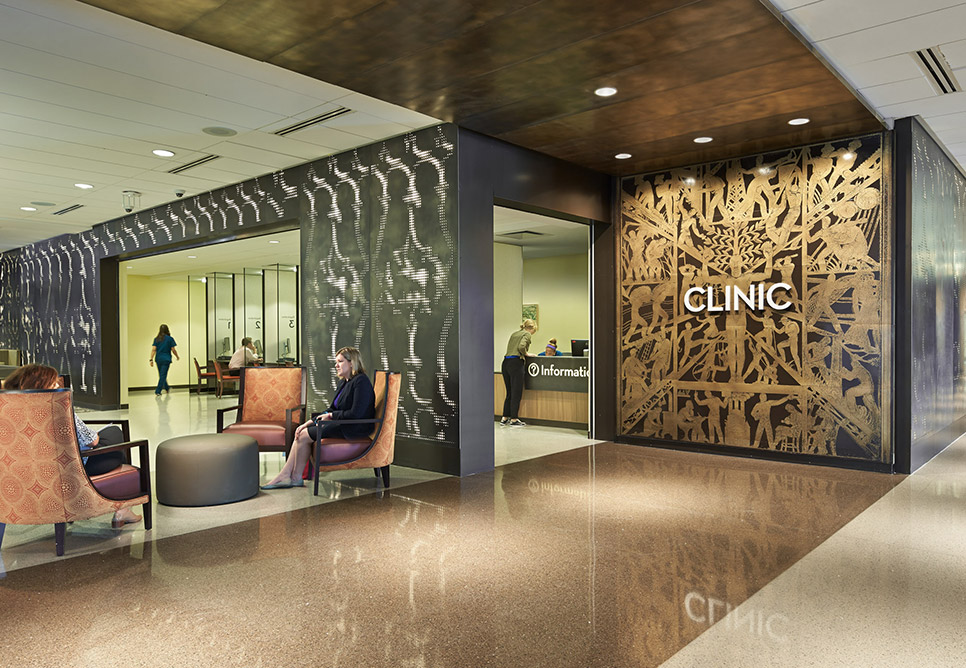
Interior rendering of UMCNO (Healthcare Design Magazine, Showcase 2016)
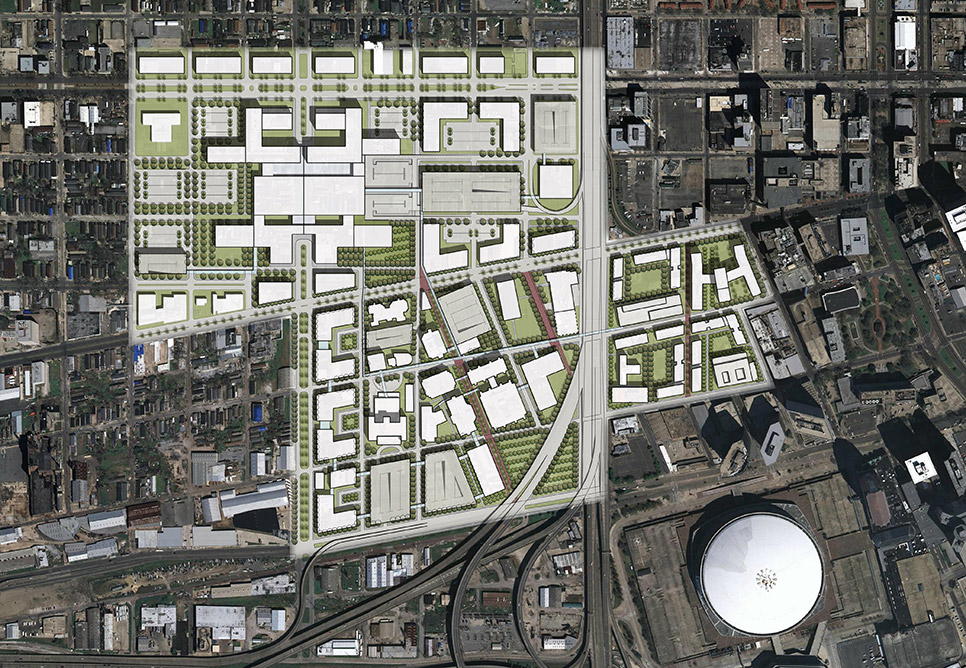
Master plan of UMCNO and the VA hospital combined